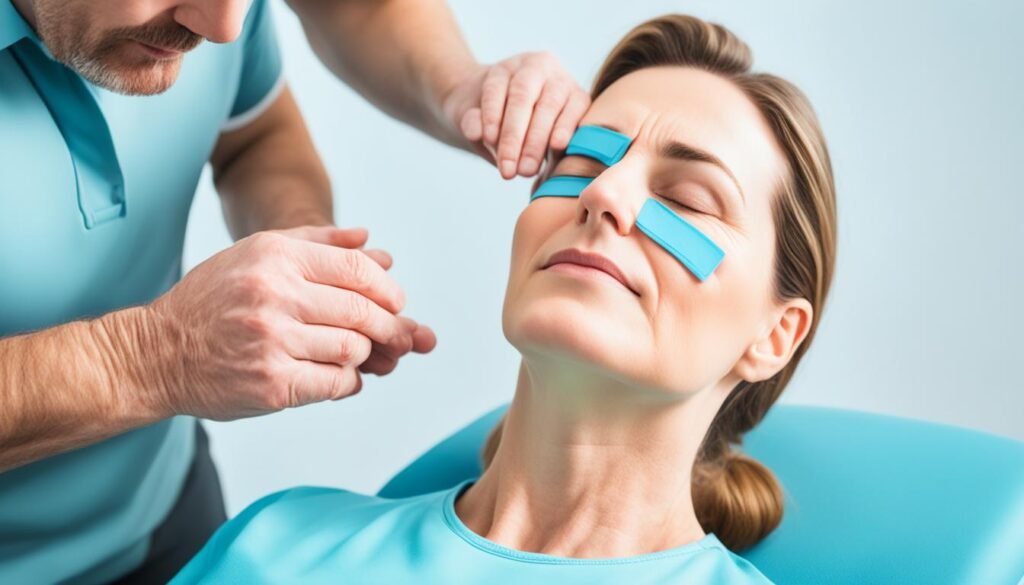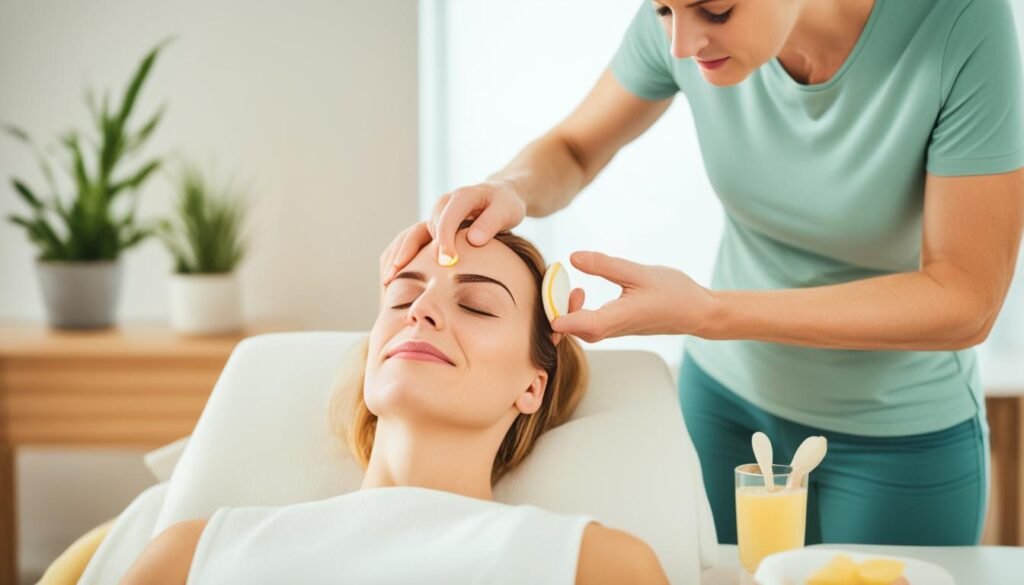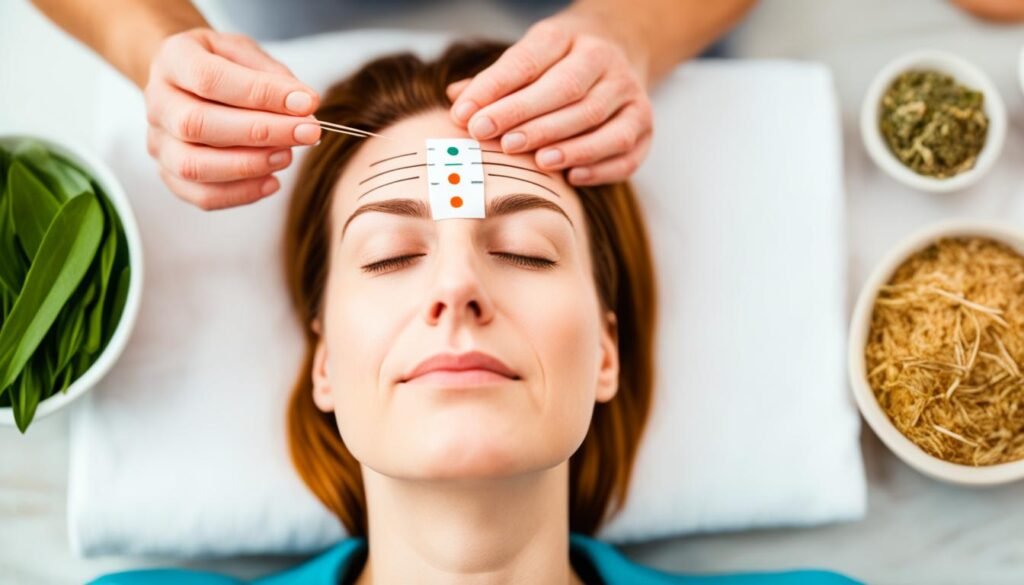Bell’s Palsy is a condition that affects the facial nerve, causing weakness or paralysis on one side of the face. One of the common complications of Bell’s Palsy is eye involvement, leading to the inability to close the eye properly and resulting in potential eye dryness and other complications. This article will explore effective treatment options for Bell’s Palsy that specifically target eye care and vision protection.
Table of Contents
ToggleKey Takeaways:
- Bell’s Palsy can cause eye complications due to the inability to close the affected eye properly.
- Effective treatment options for Bell’s Palsy eye care include medications, physical therapy, surgical procedures, home remedies, and alternative medicine approaches.
- Medications like corticosteroids and antiviral drugs can help reduce inflammation and speed up recovery.
- Physical therapy exercises can prevent muscle shrinkage and maintain muscle tone.
- In some cases, surgical options like facial reanimation surgery may be considered for severe Bell’s Palsy.
Diagnosis of Bell’s Palsy
Bell’s Palsy is typically diagnosed based on a physical examination and evaluation of symptoms. One of the key indicators of Bell’s Palsy is facial muscle weakness, which is usually present on one side of the face. If you suspect that you may have Bell’s Palsy, it is important to seek medical attention for an accurate diagnosis.
During your appointment, your healthcare provider will conduct a thorough physical examination, focusing on your face and facial muscles. They will assess the extent of muscle weakness and any other associated symptoms. Your medical history, including any recent illnesses or conditions, will also be considered.
While the physical examination is critical, additional tests may be performed to confirm the diagnosis and rule out other potential causes of facial muscle weakness. These tests may include:
- Electromyography (EMG): This test measures the electrical activity in the facial muscles, helping to determine the extent of nerve damage and assess muscle function.
- Imaging scans: Your healthcare provider may recommend an MRI (Magnetic Resonance Imaging) or CT (Computed Tomography) scan to obtain detailed images of the facial nerves and rule out other underlying conditions.
- Blood tests: These tests can help identify any underlying infections or autoimmune conditions that may be contributing to the facial muscle weakness.
These diagnostic tests assist in confirming a Bell’s Palsy diagnosis and determining the severity of nerve damage. By ruling out other potential Bell’s Palsy causes, healthcare providers can confidently develop a personalized treatment plan to address your specific needs.
| Diagnostic Tests | Description |
|---|---|
| Electromyography (EMG) | A test to measure the electrical activity in facial muscles, aiding in assessing nerve damage and muscle function. |
| Imaging scans | Non-invasive scans such as MRI or CT to obtain detailed images of facial nerves and rule out other potential causes. |
| Blood tests | Analysis of blood samples to identify any infections or autoimmune conditions that may contribute to facial muscle weakness. |
Medications for Bell’s Palsy Eye Treatment
Medications play a crucial role in treating Bell’s Palsy and accelerating the recovery process. The two main types of medications used for Bell’s Palsy eye treatment are corticosteroids and antiviral drugs.
1. Corticosteroids
Corticosteroids, such as prednisone, are commonly prescribed to reduce inflammation and swelling of the facial nerve in Bell’s Palsy. These medications work by suppressing the immune response that may be causing damage to the facial nerve.
When started within a few days of symptom onset, corticosteroids have shown to be more effective in improving facial muscle function and reducing recovery time. However, their effectiveness may diminish if started later in the course of the condition.
2. Antiviral Drugs
In some cases, antiviral drugs may be used in combination with corticosteroids for the treatment of Bell’s Palsy. Antivirals, such as valacyclovir or acyclovir, are prescribed because viral infections, particularly herpes simplex virus, are believed to be a potential cause of Bell’s Palsy.
However, the effectiveness of antiviral drugs in the treatment of Bell’s Palsy is still uncertain, and their use may depend on factors such as the severity of the condition and the presence of viral infection.
It is important to note that while medications can help manage symptoms and promote recovery, they may not guarantee a complete restoration of facial movement. Each individual case may vary, and it is essential to consult a healthcare professional to determine the appropriate medication regimen for Bell’s Palsy.

| Medication Type | Examples | Mode of Action |
|---|---|---|
| Corticosteroids | Prednisone | Reduce inflammation and swelling of the facial nerve |
| Antiviral Drugs | Valacyclovir, Acyclovir | Treat potential viral infections |
Physical Therapy for Bell’s Palsy Eye Treatment
In addition to medications, physical therapy is an essential component of the comprehensive treatment plan for Bell’s Palsy. Physical therapy aims to prevent muscle shrinkage and promote recovery. By engaging in specific facial muscle exercises and massage techniques, you can stimulate and strengthen the affected muscles, helping to maintain muscle tone and prevent permanent damage.
Working with a skilled physical therapist, you will learn exercises that target the muscles involved in facial expression. These exercises typically focus on improving muscle control, coordination, and strength. Regular practice of these exercises can lead to better control and mobility of your facial muscles. It is important to be consistent and follow the guidance of your physical therapist to maximize the effectiveness of the exercises.

| Benefits of Physical Therapy for Bell’s Palsy | Examples of Facial Muscle Exercises |
|---|---|
| Prevents muscle shrinkage | 1. Forehead lift: Raise your eyebrows as high as possible while keeping your eyes wide open. Hold for a few seconds and repeat. 2. Smile exercise: Smile as widely as you can, holding the position for a few seconds. Relax and repeat. 3. Pucker exercise: Pucker your lips as if you were kissing, hold for a few seconds, and then relax. |
| Promotes circulation and healing | 4. Eye squeeze exercise: Close your affected eye tightly for a few seconds, then relax. Repeat several times. 5. Cheek puff exercise: Puff your cheeks out, hold for a few seconds, and release. Repeat. 6. Tongue push exercise: Push your tongue forcefully against the roof of your mouth and hold for a few seconds. Relax and repeat. |
| Improves muscle control and coordination | 7. Symmetry exercise: Attempt to raise the corners of your mouth equally on both sides to achieve a balanced smile. Hold for a few seconds and repeat. 8. Face tapping exercise: Gently tap your fingers across your face, targeting the affected areas. This exercise helps stimulate blood flow and nerve function. |
By incorporating these exercises into your daily routine, you can support the recovery process and regain control over your facial muscles. Remember to always consult with your healthcare provider or physical therapist before starting any new exercise regimen.
Surgical Options for Bell’s Palsy Eye Treatment
In rare cases of severe Bell’s Palsy or when other treatments have not been effective, surgery may be considered. Decompression surgery, which involves opening the bony passage where the facial nerve passes through, is no longer recommended. However, facial reanimation surgery offers promising options for restoring facial movement and improving symmetry in facial features.
Facial reanimation surgery includes various procedures that can be tailored to individual needs. These procedures aim to address the specific effects of Bell’s Palsy on facial expression and restore a more natural appearance. Some of the common surgical options for Bell’s Palsy treatment include:
- Eyebrow lift: This procedure helps improve the positioning and movement of the eyebrow, enhancing overall facial symmetry.
- Eyelid lift: An eyelid lift surgery can correct droopy or paralyzed eyelids, allowing for better eye closure and protection.
- Facial implants: Implants can be used to provide structural support and improve facial contours in areas affected by muscle weakness.
- Nerve grafts: Nerve grafting involves replacing damaged or non-functioning nerves with healthy nerves taken from another part of the body. This can help restore facial muscle movement and improve facial function.
These surgical procedures are typically performed by a skilled plastic surgeon or facial reconstructive surgeon. The choice of surgical options may vary depending on individual circumstances and the extent of facial paralysis. It is essential to consult with a qualified healthcare professional to determine the most appropriate surgical approach for your specific needs.
Risks and Recovery
As with any surgical procedure, there are potential risks and complications associated with Bell’s Palsy facial reanimation surgery. These may include infection, scarring, nerve injury, and unsatisfactory results. Recovery time can also vary depending on the extent of surgery and individual healing ability.
It is important to follow the post-surgical instructions provided by your surgeon carefully. This may include precautions to protect the surgical site, such as avoiding strenuous activities and practicing good wound care. Regular follow-up appointments will be necessary to monitor the progress and address any concerns during the recovery period.
While surgical options can provide significant improvements in facial movement and appearance, it is important to have realistic expectations and understand that complete recovery may not be possible for everyone. Your surgeon will provide detailed information about the potential benefits, risks, and expected outcomes of the specific surgical procedures recommended for your case.
| Surgical Options | Description |
|---|---|
| Eyebrow lift | Lifts and repositions the eyebrow to enhance facial symmetry. |
| Eyelid lift | Corrects droopy or paralyzed eyelids for better eye closure and protection. |
| Facial implants | Improves facial contours and provides structural support in areas affected by muscle weakness. |
| Nerve grafts | Replaces damaged or non-functioning nerves with healthy nerves from another part of the body to restore facial muscle movement and function. |

It is important to note that surgical options for Bell’s Palsy eye treatment are typically considered when other non-surgical interventions have not been effective. Your healthcare provider will assess your specific case and discuss the potential benefits, risks, and alternatives with you to determine the best course of action.
Home Remedies for Bell’s Palsy Eye Treatment
Along with medical treatments, there are certain home remedies that can provide relief and support recovery in Bell’s Palsy. These remedies can be used in conjunction with prescribed medications and therapies to enhance the healing process. Here are a few home remedies you can try:
Pain Relievers
In Bell’s Palsy, the facial nerve weakness or paralysis can cause discomfort or pain in the affected area. Over-the-counter pain relievers, such as acetaminophen or ibuprofen, can help manage these symptoms. It is crucial to follow the recommended dosage and consult with a healthcare professional before starting any pain medication.
Facial Exercises
Performing facial exercises as recommended by a healthcare professional can help prevent muscle degeneration and promote better facial muscle control. These exercises target the affected muscles and help improve their strength and coordination. Here’s an example of a simple facial exercise:
- Sit comfortably and relax your face.
- Gently close your eyes.
- Try to raise your eyebrows as much as possible.
- Hold this position for a few seconds, then relax.
- Repeat the exercise 10 times, twice a day.
Remember to start with gentle movements and gradually increase the intensity as tolerated. It is important to perform these exercises regularly and under the guidance of a healthcare professional to ensure their effectiveness and safety.
Comparison of Bell’s Palsy Home Remedies
| Home Remedies | Benefits | Precautions |
|---|---|---|
| Pain Relievers | – Manage discomfort and pain – Improve overall well-being |
– Follow recommended dosage – Consult with a healthcare professional |
| Facial Exercises | – Prevent muscle degeneration – Promote better facial muscle control |
– Perform under professional guidance – Start with gentle movements |
While these home remedies can provide relief and support recovery in Bell’s Palsy, it is important to remember that they do not replace medical treatments or professional guidance. Always consult with a healthcare professional to discuss personalized treatment options and address any concerns you may have.

Alternative Medicine for Bell’s Palsy Eye Treatment
While scientific evidence is limited, some alternative medicine approaches may be beneficial for individuals with Bell’s Palsy. These alternative treatments can complement conventional medical interventions and provide additional relief from symptoms.
Acupuncture

Acupuncture is an ancient Chinese therapy that involves the insertion of thin needles into specific points on the body. In the case of Bell’s Palsy, acupuncture can be used to stimulate nerves and muscles, promoting better blood flow and reducing inflammation. This can help alleviate facial paralysis and improve overall muscle control. While the exact mechanism behind acupuncture’s effectiveness in treating Bell’s Palsy is not fully understood, it has shown promising results in some individuals.
Biofeedback Training
Biofeedback training is a technique that allows individuals to gain control over certain bodily functions using their thoughts and mind-body connection. It involves monitoring certain physiological processes, such as muscle activity or skin temperature, and learning to control them consciously. In the case of Bell’s Palsy, biofeedback training can help enhance the control and coordination of facial muscles. By learning to relax and engage specific muscles, individuals can improve muscle strength and symmetry, leading to better facial movements and functional outcomes.
Botulinum Toxin Injections
Another alternative treatment option for managing symptoms of Bell’s Palsy is the use of botulinum toxin injections. Botulinum toxin, commonly known as Botox, is a purified form of the toxin produced by the bacteria Clostridium botulinum. When injected into specific facial muscles affected by Bell’s Palsy, it temporarily weakens or paralyzes the muscles, reducing spasms, twitching, and improving facial symmetry. Botulinum toxin injections can provide relief from involuntary muscle movements and help individuals regain control over their facial expressions.
It’s important to note that while these alternative approaches may provide relief for some individuals, they should always be used in conjunction with conventional medical treatments and under the guidance of a qualified healthcare professional. The effectiveness and safety of alternative medicine treatments may vary from person to person, and it’s crucial to consult with a healthcare provider before incorporating them into your treatment plan.
Eye Care for Bell’s Palsy
Due to the inability to fully close the eye on the affected side, it is crucial to take proper care of the eye in Bell’s Palsy. Protecting the eye from potential injuries and preventing dryness is essential for maintaining eye health and promoting healing.
Using Lubricating Eye Drops
To prevent dryness and maintain moisture in the eye, it is recommended to use lubricating eye drops during the day. These drops can provide relief from discomfort and help keep the eye lubricated, reducing the risk of complications. Consult with your healthcare provider to determine the most suitable lubricating eye drops for your specific needs.
Using an Eye Ointment at Night
Applying an eye ointment at night can further aid in preventing dryness and improving eye comfort during sleep. The ointment forms a protective barrier and helps retain moisture, ensuring that the eye stays hydrated throughout the night. Follow your healthcare provider’s instructions on the proper application of the eye ointment.
Wearing Glasses or Goggles
During the day, wearing glasses or goggles can provide additional protection for the affected eye. These eye-wear accessories act as a shield, guarding the eye against potential injuries from environmental factors, dust, and debris. Choose glasses or goggles that fit comfortably and provide adequate coverage.
Using an Eye Patch
Using an eye patch at night can be beneficial in certain cases of Bell’s Palsy where the eye cannot close completely. An eye patch helps to protect the eye from potential injuries during sleep, ensuring its safety and preventing further complications. Consult with your healthcare provider to determine if an eye patch is appropriate for your particular condition.
Regular Monitoring by an Eye Doctor
In severe cases of Bell’s Palsy, regular monitoring by an eye doctor may be necessary to assess the health of the affected eye and detect any potential complications. The eye doctor can provide specialized care and guidance, ensuring that the eye remains protected and any issues are addressed promptly to prevent long-term damage.

Incorporating these eye care practices into your daily routine can significantly support the healing process and safeguard the affected eye. Remember to consult with your healthcare provider or eye doctor for personalized recommendations and guidance specific to your condition.
Preparing for Bell’s Palsy Eye Treatment Appointment
When preparing for your Bell’s Palsy eye treatment appointment, there are a few important steps you can take to ensure you make the most of your time with your healthcare provider. By documenting your symptoms, preparing a list of questions, and compiling a medication list, you can have a productive discussion and gain a better understanding of your condition.
Documenting Symptoms and Major Stresses
Before your appointment, take the time to document your Bell’s Palsy symptoms, including any related major stresses or life changes you may have experienced. This information can provide valuable insights into the potential causes and triggers of your condition, helping your healthcare provider tailor the treatment plan to your specific needs.
Preparing a List of Questions
Having a list of questions ready for your appointment will ensure that you address any concerns you may have and gather all the necessary information. Consider asking about the likely cause of your Bell’s Palsy symptoms, available treatment options, potential side effects of medications, and how to manage any other health conditions you may have alongside Bell’s Palsy. This way, you can have a comprehensive understanding of your condition and actively participate in your treatment decisions.
Compiling a Medication List
It is crucial to compile a complete list of all medications and supplements you are currently taking, including the dosage, frequency, and any changes you may have made recently. This information will help your healthcare provider assess any potential drug interactions and identify the most suitable treatment options for you.
By following these preparation steps, you can ensure a productive Bell’s Palsy eye treatment appointment and actively engage in your journey towards recovery. Remember, effective communication and partnership with your healthcare provider are key to achieving the best possible outcomes.
Conclusion
Bell’s Palsy eye treatment involves a combination of medical interventions, home remedies, and proactive eye care. Early diagnosis is crucial in order to start appropriate medications and physical therapy as soon as possible. Surgical options may be considered in severe cases. Home remedies and alternative medicine approaches can provide supportive care, while proper eye care is essential in protecting the affected eye.
By following a comprehensive treatment plan and seeking regular medical guidance, individuals with Bell’s Palsy can effectively manage their condition and enhance their overall well-being. It is important to consult with a healthcare professional to discuss personalized treatment options and address any concerns specific to your case.
Remember, with the right treatment and proper care, you can safeguard your vision and aid in the recovery process. Take control of your Bell’s Palsy eye treatment and prioritize your eye health for a better quality of life.
FAQ
How is Bell’s Palsy diagnosed?
Bell’s Palsy is typically diagnosed based on a physical examination and evaluation of symptoms. Facial muscle weakness, specifically on one side of the face, is a common indicator of Bell’s Palsy. Your healthcare provider may also perform additional tests, such as electromyography (EMG), imaging scans like MRI or CT, and blood tests to rule out other possible causes and determine the severity of nerve damage.
What medications are used for Bell’s Palsy eye treatment?
Medications are often prescribed to treat Bell’s Palsy and help speed up recovery. Corticosteroids, such as prednisone, are commonly used to reduce inflammation and swelling of the facial nerve. They work best when started within a few days of symptoms onset. Antiviral drugs, like valacyclovir or acyclovir, may also be added to the treatment in some cases, although their effectiveness is still uncertain.
How does physical therapy help in Bell’s Palsy eye treatment?
Physical therapy plays a crucial role in preventing muscle shrinkage and promoting recovery in Bell’s Palsy. A physical therapist can teach you specific facial muscle exercises and massage techniques to stimulate and strengthen the affected muscles. Regular practice of these exercises can help prevent permanent muscle damage and maintain muscle tone.
Are there surgical options for Bell’s Palsy eye treatment?
In rare cases of severe Bell’s Palsy or when other treatments have not been effective, surgery may be considered. Decompression surgery, which involves opening the bony passage where the facial nerve passes through, is no longer recommended. However, facial reanimation surgery, including procedures like eyebrow lift, eyelid lift, facial implants, and nerve grafts, may be performed to restore facial movement and improve symmetry in facial features.
Are there any home remedies for Bell’s Palsy eye treatment?
Along with medical treatments, there are certain home remedies that can provide relief and support recovery in Bell’s Palsy. Taking over-the-counter pain relievers can help manage any discomfort or pain associated with the condition. Additionally, performing facial exercises as recommended by a healthcare professional may help prevent muscle degeneration and promote better facial muscle control.
Can alternative medicine approaches be beneficial for Bell’s Palsy eye treatment?
While scientific evidence is limited, some alternative medicine approaches may be beneficial for individuals with Bell’s Palsy. Acupuncture, which involves the placement of thin needles to stimulate nerves and muscles, can provide relief from symptoms. Biofeedback training, a technique that uses the power of thoughts to control body functions, may also enhance facial muscle control. Botulinum toxin injections may help manage symptoms like facial spasms and improve facial symmetry.
How should the eye be cared for in Bell’s Palsy?
Due to the inability to fully close the eye on the affected side, it is crucial to take proper care of the eye in Bell’s Palsy. Using lubricating eye drops during the day and an eye ointment at night can prevent dryness and maintain moisture in the eye. Wearing glasses or goggles during the day and using an eye patch at night can protect the eye from potential injuries. Regular monitoring by an eye doctor may be necessary in severe cases.
How should I prepare for a Bell’s Palsy eye treatment appointment?
Preparation for a Bell’s Palsy eye treatment appointment involves documenting your symptoms, including any related major stresses or life changes, and making a list of all medications and supplements you are taking. It is also essential to prepare a list of questions to ask your healthcare provider, such as the likely cause of your symptoms, available treatment options, and management of other health conditions alongside Bell’s Palsy. This preparation will help you make the most of your appointment and gain a better understanding of your condition.
Source Links

Best Neurologist Doctor In Patna: Dr Chandril Chugh Dedicated to Your Well-being
Dr.Chandril Chugh is a neurologist who trained and practiced in the USA for more than a decade. He is compassionate and caring and is most well known for being a patient listener and spending ample time with patients.
